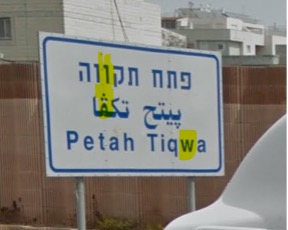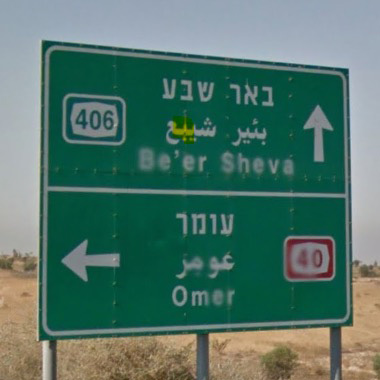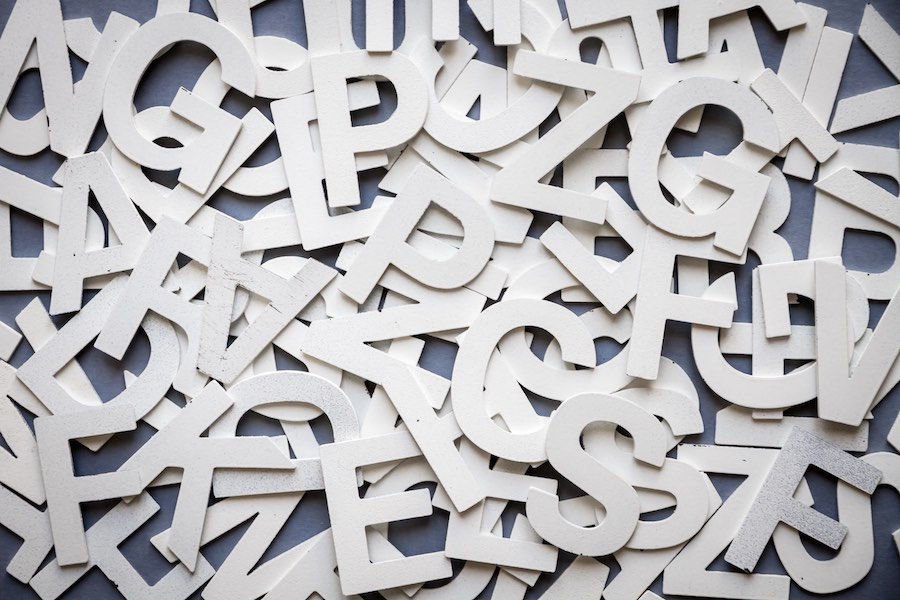It is well known that translation of a source text in one language to the target text of another language involves many challenges, especially between languages not related to each other, such as when translating from Arabic or Hebrew (Semitic languages) to English (a Latin-Germanic fusion). Do you translate literally, do you use explication, or outright omission if the word may be difficult to translate? How do you translate idioms in one language which may not be expressed in another language or expressed in a parallel idiom? What is less familiar are the challenges of transliteration.
Recently in Israel a preliminary bill was unanimously advanced in the Knesset (Israeli parliament) requiring “uniform, correct spellings in English for street signs”. For many years now the transliteration on street signs from Hebrew to English has been inconsistent, if not downright incorrect. For instance, the Golan Heights town of קצרין has been transliterated as Qatsrin, Qasrin, Katsrin or Katzrin. Another example is that the city of פתח תקוה is transliterated by the municipality as Petach Tikva in their website, but the website address is
“petah-tikva.muni.il” (with an h instead of a ch after the letters “peta”).

In addition, the street signs at the entrance to פתח תקוהare spelled as Petah Tiqwa, though no one pronounces the city with a “w”. In fact, the Arabic transliteration uses an improvised Arabic letter ڤ for the “v” sound, instead of using the readily available “w” sound in the letter “waw”(و). The result is that is the above street sign, the Arabic transliteration is a more accurate reflection of the actual pronunciation of the city than the English transliteration.

Interestingly, as an aside, while Arabic transliteration of newer Israeli cities use improvised letters for sounds that do not exist in the original Arabic alphabet, in older Israeli cities only letters in the original Arabic alphabet are used, resulting in transliterations which do not fully reflect those cities’ pronunciations.
As seen above, “peh” (پ), which is a variant of the original letter “beh” (ب) and “veh” (ڤ)which is a variant of the original letter “feh” (ف)is used to transliterate פתח תקוה in street signs but תל אביב-יפו is transliterated as Tal Abeeb-Yafa andבאר שבע is transliterated as Ber Sheeba, in both cities not substituting the original Arabic letter “beh” with the variant “veh”. Perhaps the reason is that the Arabic speaking population is so used to referring to the above cities as Tal Abeeb and Beer Sheeba.


Here is some background to explain the reasons behind the inconsistencies and the challenges one faces when transliterating a Hebrew or Arabic name into English.
In Arabic there are nine letters with no direct counterpart in English: ﺡ, ﺥ, ﺹ, ﺽ, ﻁ, ﻅ, ﻉ, ﻍ, and ﻕ. When transliterating these nine letters the following are used:
ﺡ – This letter is a voiceless pharyngeal fricative. The English letter “h” is used, such as in the words “humus” and “hijab”. In chat Arabic the number 7 is used and in the IPA (International Phonetic Alphabet) “ħ” and is therefore known as the letter “ħa” or “7a” or “ha”.
ﺥ – This letter is a voiceless velar fricative. The consonant digraph “kh” is used, such as in the names “Khalid”, “Khartoum” and “Khomeini”. In chat Arabic the number 7’ or 5 is used and in the IPA “x” and is therefore known as the letter “kha” or “7’a” or “5a” or “xa” .
ﺹ – This letter makes a deeper “s” sound produced as a pharyngealized voiceless alveolar sibilant. The English letter “s” is used such as in the words “sahbr” (patience) and “sahbaah” (morning) and “sahdeeq” (friend). In chat Arabic the letter “s” or the number 9 is used and in the IPA “sˤ” and is therefore known as the letter “sahd” “9ahd” or “sˤɑhd”.
ﺽ – This letter makes a deeper “d” sound produced as a pharyngealized voiced alveolar plosive. The English letter “d” is used such as in the words “dabab” (fog), “dafadae” (frog), “dariba” (tax). In chat Arabic the character 9’ are used and in the IPA dˤ and is therefore known as the letter “dahd”, “9’ahd” or “dˤad”.
ﻁ – This letter makes a deeper “t” sound produced as a pharyngealized voiceless alveolar plosive. The English letter “t” is used such as in the words “tawil” (tall), “talib” (student), “tayara” (airplane) and “tayib” (good). In chat Arabic the number 6 is used and in the IPA tˤ and is therefore known as the letter “ta”, 6a or tˤa.
ﻅ – This letter, rarely used in Arabic makes a deeper voiced “th” or “z” sound depending on the dialect produced as a pharyngealized voiced dental fricative. The English letters “th”, “dh” or “z” are used such as in the word “zarf” (circumstance). In chat Arabic the number 6’ is used and in the IPA ð and is therefore known as the letter “tha”, “dha”, 6’a or ða.
ﻉ – This letter is a voiced pharyngeal fricative. The English letters “a”, “ei” or “eu” is used, depending on whether the vowel attached is a fatha (“ah”), kasra (“ee”) or damma (“oo”) such as in the words “alem” (world), “eid” (holiday or festival) and “eushub” (grass). In chat Arabic the number 3 is used and in the IPA ʕ is uses and is therefore known as the letter “ayin” or “3ayin” or “ʕayin”.
ﻍ – This letter makes a sound like a French “r” and is produced as a voiced velar fricative. The English letters “gh” are used such as in the place “Ghaza” (Gaza) and the word “gharb” (west). In chat Arabic the number 3’ or 8 is used and in the IPA ɣ is used and is therefore known as the letter “ghayin” or “3’ayin” or “8ayin” “ɣayin”.
ﻕ – This letter is a “k” sound made from the back of the throat and is produced as a voiceless uvular plosive. The English letter “q” is used such as in the word “qaber” (grave or tomb) or “qarib” (close or near). In chat Arabic the number 2 is used and in the IPA q is uses and therefore is known as the letter “qahf” or “2ahf”.
Have you ever wondered why Hebrew has duplicate sounds for different letters? In Modern Hebrew the letters with duplicate sounds are:
א (the letter Aleph) and ע (the letter Ayin)
ב (the letter Vet) and ו (the letter Vav)
ח (the letter Khet) and כ (the letter Khaf)
ט (the letter Tet) and ת and תּ (the letter Tav)
כּ (the letter Kaf) and ק(the letter Koof)
ס (the letter Samekh) and ש (the letter Sin)
ת (the letter Tav) and תּ (the letter Tav)
In Modern Hebrew the Aleph and Ayin are identical and both are a kind of consonant called a “glottal stop” that are either silent at the end of a word or take the sound of the vowel sounds of “ah”(as in palm) in words such as אף(“ahf” which means “nose”), “oo” (as in zoom) in words such as אולם (“oolahm” which means “hall”), “ee” (as in beer) in words such as עיר (“eer “ which means “city”), “e”(as in pet) in words such as איפה (“efo” which means “where”) and “o”(as in note) in words such as עולם (“olahm” which means “world”).
The other letters with duplicate sounds are regular consonants. The letter ב (Vet without a “Dagesh” dot in the middle – which would change it to the letter Bet) and ו (the letter Vav) both make a “v” sound, the letter ח (Khet) and כ (Khaf), both make a “kh” (“x” per IPA) sound, the letter ט (Tet) and ת (Taf, both with and without a “Dagesh” dot in the middle) both make a “t” sound the letter כּ (with a “Dagesh” dot in the middle) and a ק (Koof), which both make a “k” sound, the letter ס(Samekh) and ש (Sin, with a “Dagesh” dot on the upper left-hand side of the letter) which both make an “s” sound.
Hebrew is a Semitic language which is very similar to Arabic. As widely known, after the Jews were defeated by the Roman Empire several times, the last time being the year 135 CE, the defeat of Shimon “Bar Kokhva” Bar Kosiba, they were driven out of the Holy Land into an almost two thousand year exile as a diaspora. Since a majority of Jews lived in Central and Eastern Europe and mostly Jews from those areas were the ones who eventually made their way back to the Holy Land in the 19th and 20th centuries, they were the ones, led by Eliezer Ben Yeduda, who revived the ancient language of Hebrew into an active spoken language. Accordingly, the pronunciation of Modern Hebrew was tailored to reflect the pronunciation of Slavic and Germanic languages which were the mother tongue of those Jews – especially if one views Yiddish as more Germanic and Slavic than Semitic. So, the sounds unique to Semitic languages were not used in Modern Hebrew and letters in the Hebrew alphabet were duplicated to reflect sounds present in the Germanic and Slavic alphabets. This is reflected as follows:
Since there is no Ayin (voiced pharyngeal fricative ﻉ also absent in English) in Germanic or Slavic languages, the Hebrew ע was not pronounced as it was in ancient Hebrew (and Hebrew used in prayer by Jews descended from North Africa and Arabic speaking nations) and instead used as a duplicate of the letter Alef א (glottal stop).
Since there is no Waw (“w” voiced labial–velar approximant sound present in English) sound in Germanic or Slavic languages, the Hebrew “ו” was not pronounced as a “w” as it was in ancient Hebrew (and Hebrew used in prayer by Jews descended from Yemen), rather as a “v”, duplicating the letter Vet (ב).
Since there is no “ħet” ( ﺡ) (voiceless pharyngeal fricative, also absent in English) sound in Germanic or Slavic languages, the Hebrew ח was not pronounced as it was in ancient Hebrew (and Hebrew used in prayer by Jews descended from North Africa and Arabic speaking nations) and instead used as a duplicate of the letter Khaf (כ) which has a voiceless velar fricative sound.
Since there is no ﻁ (pharyngealized voiceless alveolar plosive, also absent in English) in Germanic and Slavic languages, the Hebrew ט was not pronounced as it was in ancient Hebrew (and Hebrew used in pKarayer by Jews descended from Yemen), rather as a “t”, duplicating the letter Tav (תּ).
Since there is no ث (“th” voiceless dental non-sibilant fricative sound present in English) in Germanic and Slavic languages, the Hebrew ת became a Sav for Ashkenazi Jews from Central and Eastern Europe with an “s” sound. Even today Germans often pronounce the “th” used in words like “think” as “sink”. Modern Hebrew went further and made the Hebrew ת sound identical to the Hebrew תּ; i.e. as a “t” sound, though many Ashkenazim still pronounce the ת as an “s” sound in prayer and Jews descended from Yemen pronounce the ת in prayer as a “th”, like in ancient Hebrew.
Since there is no ق (voiceless uvular plosive, also absent in English sounding like a “k” from the back of the throat) in Germanic and Slavic languages, the Hebrew Kuf (ק) was not pronounced as it was in ancient Hebrew (and Hebrew used in prayer by some Jews descended from Iraq), rather as a “k” (voiceless velar plosive), duplicating the letter Kahf (כּ).
Since there is no Saad (ص) (pharyngealized voiceless alveolar sibilant, also absent in English) in Germanic and Slavic languages, the Hebrew צ became a “tz” sound in Modern Hebrew instead of the “deep s” sound.
Incidentally the other three sounds not present in Germanic and Slavic languages but present in Arabic, the Ghain, Jeem and the Daad (غ, ج and ض) are reflected in ancient Hebrew and in prayer of Jews descended from Yemen by the Ghimmel, which is the modern Gimmel without a Dagesh dot (ג), the Jimmel, which is the modern Gimmel with a Dagesh dot (גּ). The Daad had no equivalent in Hebrew, but the “th” sound as in the word “this” (voiced dental fricative sound present in English) is reflected by the Dhaled, which is a Daled without a Dagesh dot (ד). The Daled with a Dagesh dot (דּ) sounds like the Daled “d” of Modern Hebrew.
In summation Ancient Hebrew had most of the sounds of Arabic, while Modern Hebrew only has the sounds present in Germanic and Slavic languages. While purists who follow Ancient Hebrew might be technically correct, when transliterating street signs, using the sounds of Ancient Hebrew, into English, this results in the transliteration sounding much different than the actual, day to day Modern Hebrew pronunciation. The most prominent example is, in which the Kuf (ק) is transliterated as a “q” and the Vav (ו) as a “w”, while in Modern Hebrew the Kuf would be a “k” and the Vav a “v”. The most famous example is displayed at the beginning of this blog – transliterating פתח תקווה as Petah Tiqwa. Obviously Petah Tiqwa is not pronounced as it is spelled which is a problem, but what is the solution? While spelling Petah Tikva, as the municipality does, accurately reflects the “k” and “v” sounds, the “h” may not be clear to a person who does not speak Hebrew. It could be a silent “h”, which followed by an “a” makes an “ah” sound or it could be a “ħ” or ﺡ. How should letters and sounds present in Hebrew but not present in English be transliterated?
This issue and my suggested solution will be discussed in my next posted blog.
